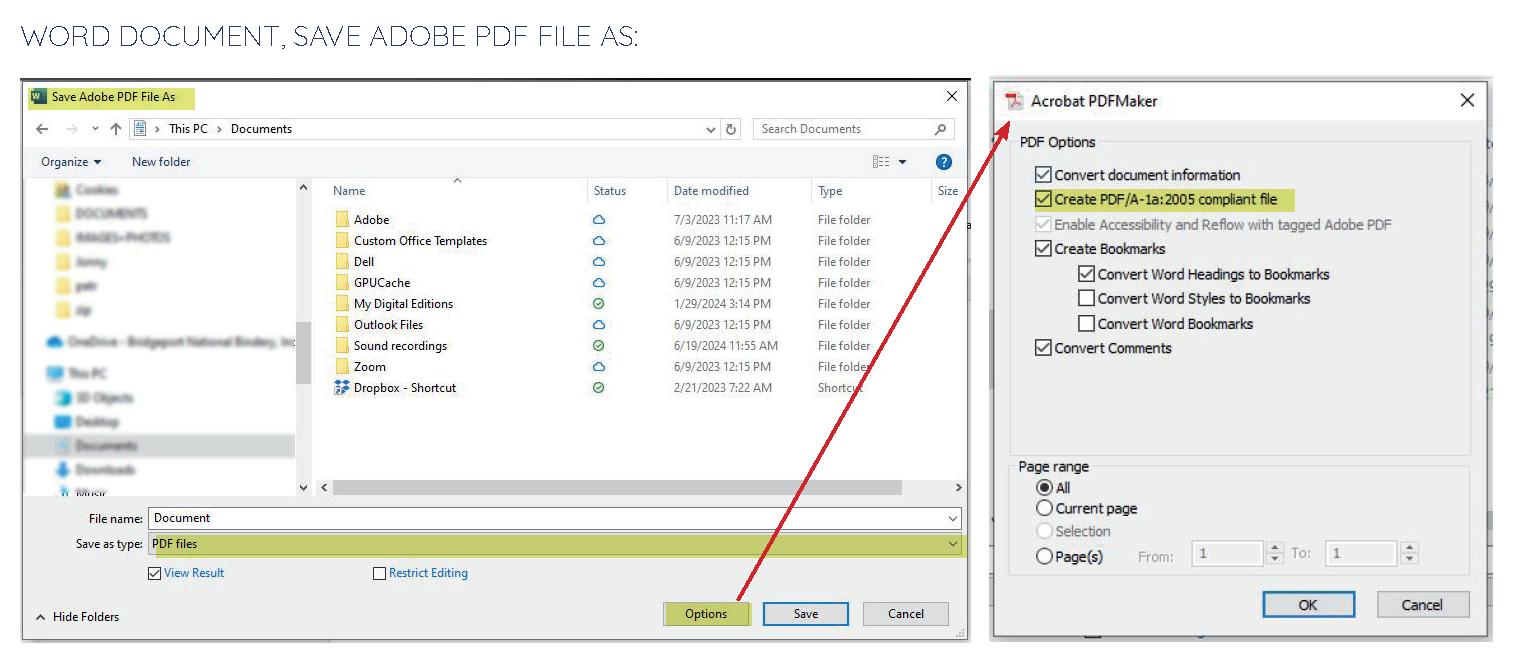File Submission Guidelines
The following information outlines the most important file submission requirements for printing and binding at BNB.
-
One single pdf, cropped to final trim size, plus any document bleeds.
Single page pdfs, not two-page spreads.
For best results, use sRGB color space when printing with BNB.
Cover is a separate pdf and not included in the text file.
Embed all images and fonts, including system fonts and font subsets. BNB does not use font substitution. Any file with unembedded fonts will be rejected.
Keep “live content” at least 0.25” in from the final trim edge.
To optimize print quality and file size, please ensure all images are at least 300 dpi (but not above 800 dpi).
Do not include printer marks (color bars, registration marks, crop marks, document info, slug or bleed marks)
All files should include 0.125” bleeds (extra canvas) on all sides of the text.
Images set to bleed off the page edge should fill 0.125” bleed area.
Do not include any extra canvas (beyond the 0.125” for document bleeds)
No pdf annotations (comment bubbles)
Flatten all layers and transparencies
Remove any document security/password protection
If grayscale images are included within color text, ensure those images are in grayscale.
-
One single pdf with contiguous front cover, back cover and spine on a single landscape-oriented canvas.
Include bleeds in final cover submission (amount of bleeds vary depending on binding).
Cover dimensions reflect the intended binding and paper stock.
Embed all images and fonts, including system fonts and font subsets. BNB does not use font substitution.
No pdf annotations (comment bubbles)
To optimize print quality and file size, please ensure all images are at least 300 dpi (but not above 800 dpi).
Keep “live content” at least 0.25” in from the final trim edge/board wrap.
Do not include printer marks (color bars, registration marks, crop marks, document info, slug or bleed marks)
Do not include text on paperback spines with a bulk of less than 0.25”.
Flatten all layers and transparencies
For best results, use sRGB color space when printing with BNB.
Additional Guidelines
-
Bridgeport National Bindery (BNB) provides digital printing and book binding services to the international community - over 75 years in the making. BNB seamlessly integrates today’s electronic ordering and on-demand digital printing with our traditional standard of quality. We offer numerous product types, services and workflows to meet your needs.
-
We encourage a cooperative workplace focused on innovation and quality, adapting to our customers’ needs – one book at a time.
-
BNB offers several product types. We can even help you test and develop new products. Our standard product offerings are as follows:
Printing
Roll-fed inkjet presses
Sheet-fed presses
Monochrome (Black & White) & Color Printing
Paperback
Perfect Bound Paperback with laminated paper cover (4/0, 4/4 cover printing)
Coil/Wire-O binding with laminated paper cover (4/0, 4/4 cover printing)
French Flap Paperback
Saddle Stitch Paperback
Casebound
Pre-printed PUR casebound (PPC) - (4C printed and laminated hardcover)
Cloth casebound with standard foil stamping (current cloth and foil colors available on request)
Cloth casebound with die stamping (dies are not produced in-house)
Jacketed casebound (dust jacket over printed laminated or cloth casebound)
-
BNB’s preferred method of file submission is either via BNB FTP, or cloud-based file sharing services (Dropbox, OneDrive, etc.). We can also accept some smaller files via email (please restrict email attachments to under 15MB in size). If you plan on recurrent orders, and would like to establish a continuous relationship with Bridgeport National Bindery, please speak to one of our Customer Service Representatives to discuss options for integration with our automated order system.
-
Please submit covers and text files with an embedded sRGB color space - this is the BNB press default and will give you the best results.. If you choose to submit your files under a different color profile, please embed the profile. Without embedded profiles, presses will default to sRGB which can cause unexpected color shifts if different from your intended color space.
Please note: Computer monitor color does not equate to printed color. Cover lamination can also affect color. Subtle color shifts may occur in digital printing. Color matching is not available for individual covers.
-
Please submit all book files at the same time with the appropriate file suffix. If the book files are contained in a single zip file, the file should be named [ISBN].zip. If you do not have an ISBN, please create and use a unique alphanumeric name. BNB refers to this as a “Book ID.” For example, a book’s files might be named SmithBio-c.pdf (cover) and SmithBio-t.pdf (text).
Please note: If you are using the same text file for different cover formats (creating a paperback and a casebound, for example), a text file must be submitted for each ISBN/unique file name.
File suffixes:
Text: -t.pdf
Cover: -c.pdf
Dust Jacket: -dj.pdf
Color Insert: -inserts.pdf
Printed Front Endsheet: -fe.pdf
Printed Back Endsheet: -be.pdf
Foldout: -fo.pdf
-
BNB offers a variety of book sizes, in both portrait and landscape orientation, as well as custom book sizes which can be discussed with your BNB Customer Service Representative.
Some popular sizes include:
(5 x 8), (6 x 9), (6.125 x 9.25), (7 x 10), (8 x 10), (8.5 x 11 -Letter), (8.25 x 11.69 - A4).
-
Due to the limitations of our printing and binding equipment, trim sizes are generally restricted to within the following dimensions.
Trim Width
Minimum: 4.25”
Maximum: 12”
Trim Height
Minimum: 6.875”
Maximum: 12”
Spine Bulk
Minimum: 0.0625”
Maximum: 2.3125”
Please discuss specific size requests with your BNB Customer Service Person. Not all sizes are available on all substrates, presses or binding equipment.
-
Not all paper stocks are available for all printing types. Please consult with your BNB Customer Service Representative to discuss the appropriate stock to use for your project, and what paper stocks are currently available. BNB currently offers these paper stocks.
PPI..........Paper Stock
444..........White 60# Uncoated
376..........White 70# ( IP Accent Opaque)
868..........White 45# Matte
526..........White 50# Uncoated
500..........White 70# (Mohawk)
526..........Cream 50# Uncoated
454..........Cream 60# Uncoated
488..........White 80# (Sterling)
542..........White 60# Silk
378..........White 100# Dull (Futura)
386..........White 100# Gloss (Futura)
258..........White 100# Eggshell (Mohawk Superfine)
646..........White 40# Uncoated
444..........White 80# Silk
-
PPI is the number of pages per 1” stack of a particular paper stock. Generally, the lower the ppi, the thicker or heavier the paper will be and the wider the calculated spine will be. The paper you and your BNB Customer Service Representative agree on can significantly affect the spine width of your cover.
-
BNB offers two film lamination finishes for casebounds, paperbacks and dust jackets.
Gloss lamination is vibrant with high-sheen and is durable - it repels dust, dirt and fingerprints.
Matte lamination is less reflective, giving a natural, rich look to cover art. It absorbs small scratches and scuffs.
-
BNB offers several different kinds of special materials and options. Please discuss the availability of any of the following with your BNB Customer Service Representative.
Shrinkwrapping
Headbands
Printed Endsheets
Color Inserts
Foldouts
Special Order Cloth or Endsheets
Ribbons
Special packing and/or shipping materials
Hole drilling (3-hole binder)
Perforated pages
Customer supplied materials, including complete book blocks, covers and/or jackets.
Document Safe Zones
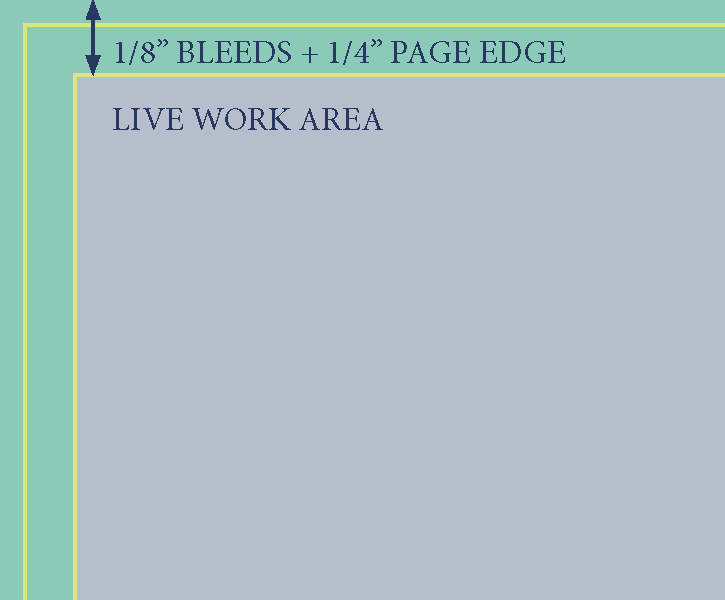
Text Safe Zone:
In addition to the standard BNB bleeds of 1/8” on all sides, we encourage you to keep any active content inside of 1/4” from the final trim size on interior pages.
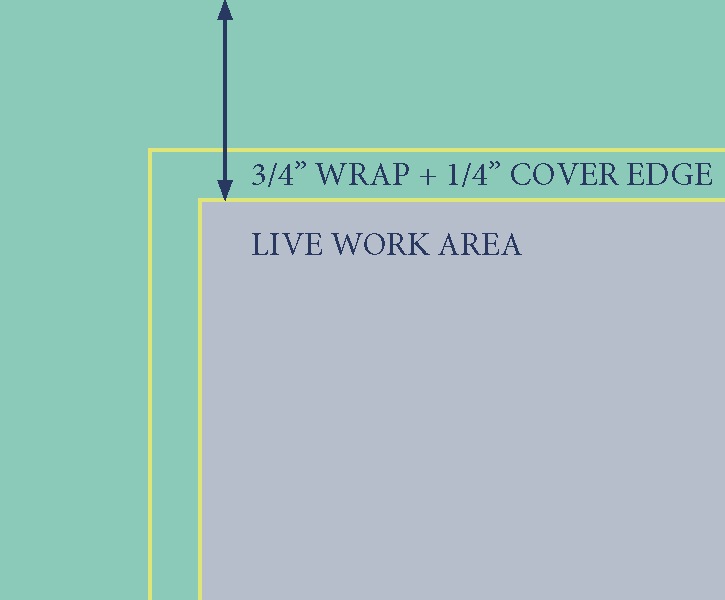
Casebound Safe Zone:
In addition to the standard BNB wrap/bleeds of 3/4” on all sides, we encourage you to keep any active content inside of 1/4” from the board edges of a hardcover book. This includes keeping active content out of the hinge area on either side of the spine.
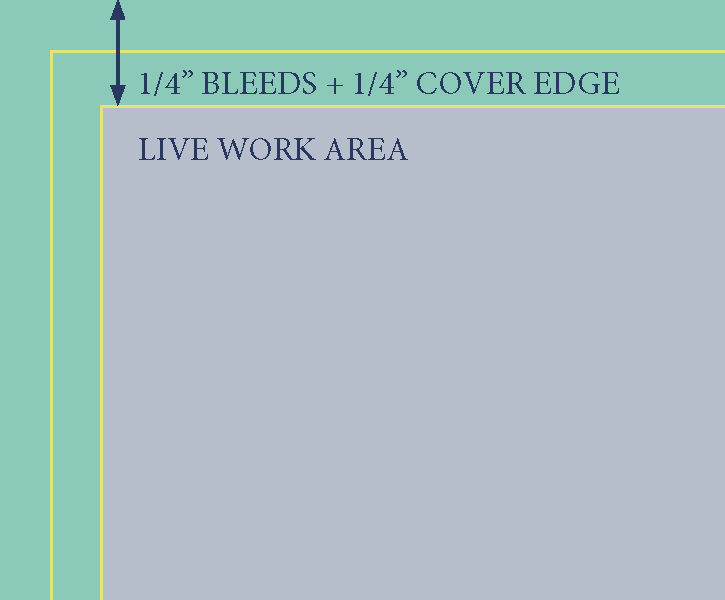
Paperback, French Flap & Saddle Stitch Safe Zones:
In addition to the standard BNB bleeds of 1/4” on all sides, we encourage you to keep any active content inside of 1/4” from the final trim line/spine edges on a paperback.
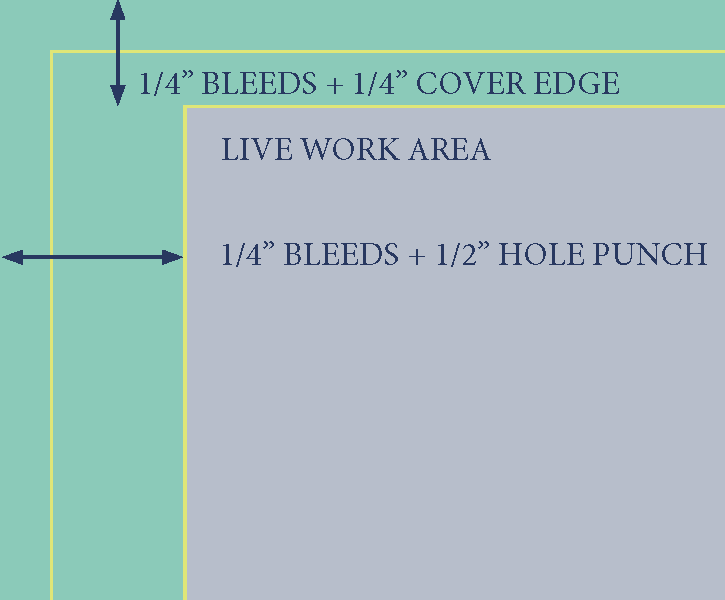
Coil/Wire-O Safe Zones:
In addition to the standard BNB bleeds of 1/4” on all sides, we encourage you to keep any active content inside of 1/4” from the final trim height line, and 1/2" on the binding edge for the hole punches.
Embedding fonts in a Word Document
BNB requires all file components to be provided as a print-ready pdf, with all fonts and font subsets embedded. Please be advised you will only be able to embed the fonts that you have permissions/license to use. Follow the guidelines below to ensure fonts are embedded in the pdf you submit.
If you are unable to embed fonts via MS Word settings, please try saving the file as a PDF/A. BNB Prepress can convert to a printable pdf.
1. Open Word document
2. File, Save as Adobe PDF
3. Click Options before saving
4. Check “Create PDF/A-1a:2005 compliant file”
5. Click OK.
6. Click on SAVE button.
Glossary of Terms
-
Extra image or color on the printed page or cover that will be removed or obscured when viewing the finished book. Sufficient bleeds ensure no white edges are seen on the final book.
-
Thick, rigid board used to make a casebound cover.
-
The thickness of a book block, without boards. Paperback spine width and spine bulk are equal.
-
The area in a file that contains the text or cover artwork. BNB prefers no extra blank canvas around text or covers.
-
Joining two cover boards and spine board together with the covering material to make a hard cover (case) for the book block.
-
A black plastic coil is inserted into punched holes on the book block and cover, binding the pages together. Coil bindings are “open,” and do not have a spine.
-
Protective, laminated paper cover material wrapped around the book horizontally, with flaps folded inside the cover. Traditionally used with hardcover books.
-
The folded sheets of paper which connect the cover and the book block. The paste-down is the side glued to the cover board. Each book has two endsheets - front and back. The flyleaf is the loose end protecting the first and last page. BNB standard endsheets are white. We also offer printed endsheets, single or two-sided.
-
Printed sheet larger than the book that is folded to the approximate trim size, and either bound into the book or as a loose insert.
-
A paperback book with an elongated cover which is folded in and made to fit within the trim size of the finished book. The portions folded in are called French flaps.
-
Strip of decorative fabric glued to the head and tail of a casebound book at the binding. Standard headbands for BNB are white, and are available on request. Other color options may be available on a limited basis.
-
Spaces between the spine edge and cover boards which allow the hardcover to open freely. BNB standard joint is 0.4375”.
-
Illustration or photo pages, typically printed in color on different paper stock from the main text and bound with the text in a fixed location. Generally reserved for a small amount of color pages in a single location within otherwise black and white text.
-
Abbreviation for International Standard Book Number. This is a 10 or 13 digit number assigned to all books published throughout the world. BNB does not provide ISBN numbers.
-
Thin plastic film applied to printed covers for durability. Matte (soft, less reflective) and gloss (shiny) laminates are available at BNB.
-
A bind style that utilizes a plastic or metal piece to bind covers and book block together, as opposed to glue. BNB offers plastic Coil and metal Wire-O binding. These bindings are “open,” and do not have a spine.
-
The number of sheets of paper that can fit in a stack of paper 1” high. Different paper stocks have different PPI. Higher PPI generally indicates a thinner or more highly calendered paper.
-
This department verifies files adherence to the file submission guidelines and troubleshoots files before printing. Some prepress work is a courtesy, while other services are subject to a file handling fee. Please discuss with your BNB Customer Service Representative.
-
BNB prints from PDF files exclusively. Please ensure PDFs are at the appropriate dimensions without extra bleeds or canvas and fonts are embedded. All book components (text, cover, inserts, endsheets, etc.) should be in separate files. Text files should be one multi-page pdf, and single page orientation as opposed to 2-page spreads.
-
When creating covers and text, please include a buffer of space along the trim lines or wrap edge to ensure active page content does not get trimmed or obscured by the case wrap.
-
The thickness of the bound book. Casebound spine width equals spine bulk plus board width.
-
Foil stamped onto cover using heated metal plates. Die and text-only stamping are done on-site at BNB.
-
The printed pages that make up the interior of the book.
-
The final dimensions of the book block. Finished paperback books are equal to the trim size. Finished casebound books are approximately 0.25” larger than the final trim.
-
A double metal wire binds the cover and book block together via punched holes. Wire-O bindings are “open” and do not have a spine.
-
The part of the cover material which is wrapped over the edges of the boards, creating a finished edge for the hardcover book.
Digital World vs. Real World: Manufacturing Tolerances
While we strive to make sure your finished book is the best representation of your files, be aware that in the ‘real world,’ there are many variables to consider. Variations in materials, equipment, staff and weather (yes, even weather!) can affect the appearance, fit and trim of your finished book. 1/8” is considered by BNB to be within manufacturing tolerances. We suggest keeping “live” content at least 0.25” away from the final edges of both cover and text.



